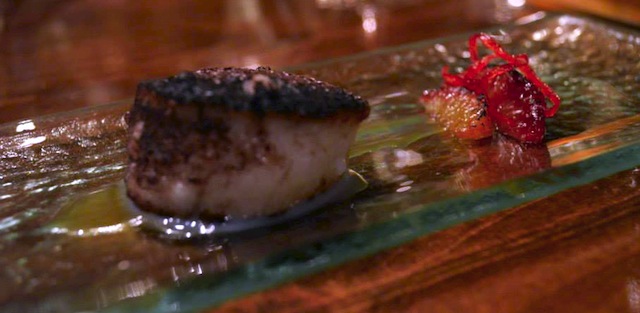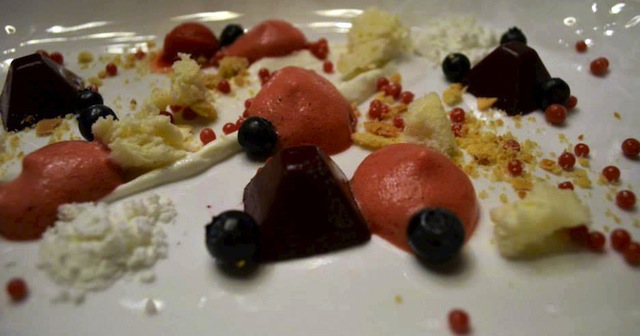
“For your amuse-bouche we have a cocoa-dusted day boat scallop and some caramelized blood orange, which I’ve paired with a cocktail called “All the Thyme in the World.”
I look down at my plate, where a plump scallop sits, dark cocoa powder contrasting with the shellfish’s light color and a smear of bright orange illuminating the plate. The complementary cocktail is crafted with Carbay Blood Orange Vodka, Sorel Spiced Hibiscus Liquor, tamarind and pomegranate juices, and garnished with a grilled orange and a thyme sprig. Like the dish, this drink is thoughtfully prepared, the orange slice dipped into granulated sugar and roasted with a concentrated flame from a kitchen torch, and the thyme slapped to release the essential oils into the glass.
While the presentation is what you would expect to find in New York City or Los Angeles, I’m actually dining at Whiteface Lodge’s KANU Restaurant … in Lake Placid. While mountain resort towns are typically known for their meat and potatoes-style cuisine, KANU is adding a twist to the local dining scene, incorporating a farm-to-form philosophy while also experimenting with atypical pairings and presentations.

KANU Restuarant
Executive Chef David Haick is the creative mind behind KANU’s innovative menu. As a vegetarian (90% vegan), he adds a more delicate touch to the hearty, calorie-rich dishes that dominate the culinary scene of this mountain village. Luckily, I’ve been graciously invited to partake in a six-course Chef’s Table dinner to experience it for myself.
“I want to serve cuisine that is not typically served on the main strip in Lake Placid,” explains Chef Haick. “Items I consider when planning a menu are regional ingredients, foraged items, and the local farms. I like to showcase local farmers on our menus, thus giving back to the community, and sharing the fruits of their labor.”

Apple Carpaccio
After the amuse-bushe, I’m brought a Hidden Rose Apple Carpaccio with finger lime, walnuts, local goat cheese and celery. The restaurant’s sommelier, Scott Waller, pairs this dish with a 2003 Nicholas Joly, Savennieres”Clos de la Bergerie” from France.
“When pairing a dish, I use a narrowing set of criteria to help make a selection,” explains Scott. “First I look at the base ingredient and cooking method, and decide if it shows light, medium or full bodied characteristics. Poaching of fish is lighter in style, braising of game is heavy in style. Next I explore the supporting components of sauce and dominant herbs. This I would also consider in terms of relative lightness or fullness. Cream sauces and raw aromatic herbs would be heavier, and consumes and vinaigrettes would be lighter.”
While Chef David enjoys sourcing locally when he can, he’ll purchase ingredients from other places when they add a unique element to a dish. For example, the Hidden Rose Apples are from Oregon, home of the one sole producer in the world of this variety. The walnuts and apples are the key to this dish, and the wine compliments this with flavors of nut and orchard rather than fruits, getting more expressive as it warms up.
From there we sample a Tucker Farm Potato Gratin with White Alba and and Black Perigueux Truffle served in a miniature cast-iron crock pot.
My server smiles. “Chef has requested I leave the lid on so when you open it you really experience the aromas of the truffle.”

Truffle Potatoes
And I’m glad he did, as immediately upon lifting the top a whiff of earth, nuts and cream envelopes my senses. Scott pairs this dish with an Ommegang “Rare VOS” from Cooperstown, New York. The beer is a Belgian-style cafe ale brewed with sweet orange peel, coriander and Grains of Paradise for a fruity yet spicy flavor and mellow essence.
“Beer can at times be more complementary to dishes than wine,” says Scott. “One of the big differences between the two is acidity. Naturally occurring in wine, it gives wine its palate refreshing characteristics; however, there are times you want a dish to be supported, not contrasted. Beer also has the ability to be palate refreshing with its natural carbonation.”
We veer from the menu a bit when I’m informed KANU’s Pizza Margherita is a must-try, and I request to sample some. What’s interesting about KANU’s Pizza Margherita compared to what you’ll usually find in Lake Placid is its authenticity. Along with making their own sauce, they buy Caputo flour and real buffalo mozzarella from Italy. Diners can watch their pizza being baked in a real wood fire oven.
“I think of it as educating. I know we should create items that are common, so that locals can identify with the cuisine. But, that will only take us so far; being creative and different will take you further in the long run,” says Chef David. “Inventive and being innovative is why most people come out to eat, for the excitement and the experience. Enjoy food that they cannot have at home, or elevating something that is common, such as our Pizza Margherita. Using great authentic ingredients.”

Bone-In Filet
Back to the tasting menu, I’m brought a Kilcoyne Farm Bone-In Filet, a unique cut fabricated specifically for Whiteface Lodge, with Chef David communicating the specifications he required to the farm and its butcher. The result is a bone that gives the filet a fuller, better taste and Umami (beefy flavor).
“Kilcoyne Farm supplies a lot of restaurants in the area, and not one has ever requested or as served such a great piece of meat,” Chef David explains. “These are the items that are not serve typically in this area, this is what will make us a destination.”
The filet is served with three onion marmalade, parsnips, baby carrot and butternut squash. Because there isn’t much fat in the meat, Scott chooses a wine with less tannins that also matches the sweetness of the squash, a 2008 Allegrini “Palazzo della Torre” from Veneto, Italy. Because the winemaker waits for the grapes to turn to raisins, it has a raisin flavor while also showcasing depth and concentration to enhance the meal.

Fruit and Yogurt — KANU-style
While all of the savory dishes are beautifully presented, it’s the dessert courses that are the true works of art. On my menu it says “Fruit & Yogurt,”; however, what I’m brought is a deconstructed version that would make Picasso jealous. Chunks of yogurt sponge, blueberry cremeux, lemon powder, raspberry pearls, yogurt crema, carbonated blueberries, whipped blackberry, vanilla sable with almond, strawberry sorbet, and a side of strawberry-basil soda adorn a spotless white plate, for a vibrant dish with complex flavors and textures. Scott pairs with a Framboise Lambic, which plays with the effervescence of the fruit in a way that’s not forced.

Savory Desserts
Dessert isn’t over yet, however, as Chef prepares a trio of savory desserts, a cauliflower-white chocolate truffle, sweet pea financiere, and tomato pate de fruit. It’s paired with a Great Adirondacks “Whiteface Stout” topped with heavy cream and Frangelico, for a chocolate flavor hinted by sweet berries.
More impressive than KANU’s dessert menu is it’s dessert flight list. The flight book is expansive: ice wines, botrytis wines, ruby ports, tawny ports, sherries, madeiras, malt scotches, peat scotches, barrel scotches, aged scotches, ged rums, grand marniers, armagnacs, house cognas, calvados, grappas, amaros, tequilas, mezcals, bourbons, New York whiskeys, artisanal gins, and an interesting Blind Vodka Challenge flight that takes the branding out of tasting and allows people to decide what they really like.
“KANU is becoming a go-to spot for becoming educated on styles of spirits, wines and beers,” explains Scott. “We have a book of 25 different “flights” that offer samplings of spirits and dessert wines that normally you would only order one of. Our flights explain how each is produced, with flavor descriptions and are presented in sets of three small tastings within each category. This program gives our guests better knowledge and sensory experiences when they travel away from our resort.”

Tawny Port Tasting
I opt for the tawny port flight. According to Scott, tawny port is aged in barrels for many years, which helps soften the wine. This is when it changes from ruby red to a reddish brown “tawny” color and its delicious flavors of caramel and nut, as well as toasty notes, become apparent. I’m given a snack of almonds and blue cheese crumbles to enhance the tastes, as I dive into a Niepoort “10yr Tawny,” which is bright in color yet light a smooth. Almonds and walnuts on the nose complement the bites in my mouth. From there I sample a 1994 Smith Woodhouse “Colheita Tawny,” a rare Tawny from a single harvest year that’s deep and rich in flavor with a warm and toasty finish, as well as a Graham’s “20yr Tawny,” a smooth and supple Tawny rich in almond notes and balanced in fruit.
As I finish my last sip of port, I realize I’m exquisitely tipsy and satisfied. Not only that, I feel inspired and more knowledgeable, as if I’ve just taken a course in food and beverage. It was something I wasn’t expecting to find in Lake Placid, a village where people come to hit the slopes, conquer high peaks and climb ice and rock face. While it’s the adventure that has typically drawn people to Lake Placid, KANU is an attraction in itself that introduces visitors to the local flavors of the area in way that hasn’t been done before.

Jessica Festa is the editor of the travel sites Jessie on a Journey (http://jessieonajourney.com) and Epicure & Culture (http://epicureandculture.com). Along with blogging at We Blog The World, her byline has appeared in publications like Huffington Post, Gadling, Fodor’s, Travel + Escape, Matador, Viator, The Culture-Ist and many others. After getting her BA/MA in Communication from the State University of New York at Albany, she realized she wasn’t really to stop backpacking and made travel her full time job. Some of her most memorable experiences include studying abroad in Sydney, teaching English in Thailand, doing orphanage work in Ghana, hiking her way through South America and traveling solo through Europe. She has a passion for backpacking, adventure, hiking, wine and getting off the beaten path.








